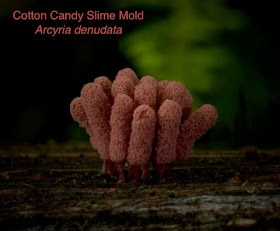 Today's blog is by the our award winning photographer of fungi, Dr. Mark Bower. I asked him to tell us a little about slime molds, with added comments in italics by your editor.
Today's blog is by the our award winning photographer of fungi, Dr. Mark Bower. I asked him to tell us a little about slime molds, with added comments in italics by your editor.
For lack of a better idea, Slime Molds have been placed in the Kingdom Protista along with amoebas, algae, kelp and other oddballs. They spend most of their lives as single-cell amoeba-like individuals, oozing around in soil, feeding on bacteria and fungal spores. Yummy, delicious.
 |
They are extremely common- one pinch of forest soil may contain around 50,000 individuals. They have been found in a wide variety of ecosystems, from the arctic to the deserts of Namibia. While they are virtually indistinguishable from amoebas, there is one important difference: unlike amoebas, Slime Molds, under certain circumstances, join together to form a completely new multicellular organism. In the case of the myxomycetes this new organism consists of a mass of slimy goo called the plasmodium. No more barefoot walks in the woods for me.
 |
| Slime mold imitating a millipede |
The slimy plasmodium creeps around, feeding and enjoying itself until it decides to stop and morph into its fruiting bodies, which produce its spores. If you think myxomycetes are weird, let me tell you about dictyostelids some day! Be still my foolish heart!
 |
| Plasmodium of Ceratiomyxa fruticulosa |
Here is the decidedly slimy plasmodium of Ceratiomyxa fruticulosa - the white stringy things are the developing fruiting bodies. Grapes of wrath?
 |
| Mature fruiting bodies |
 |
| Pretzel past its best used by date |
 |
| Dead finger applauding Mark's pictures |
Here is an entertaining three minute video that further explains slime molds. Many more of Mark's slime mold photos are at this Flickr link. Here is more from your National Park Service.
Thanks Mark, now off to dinner!

